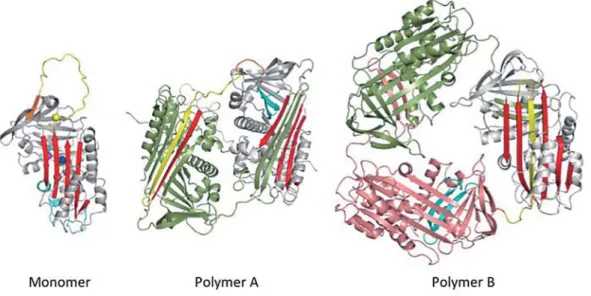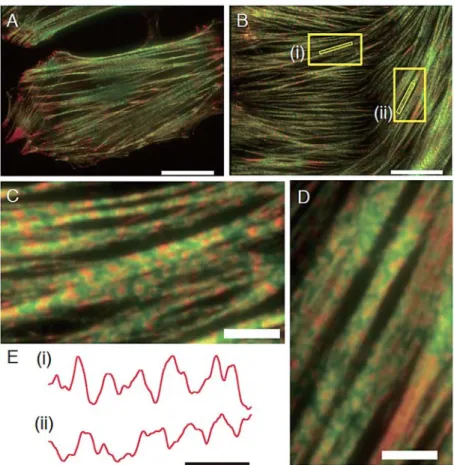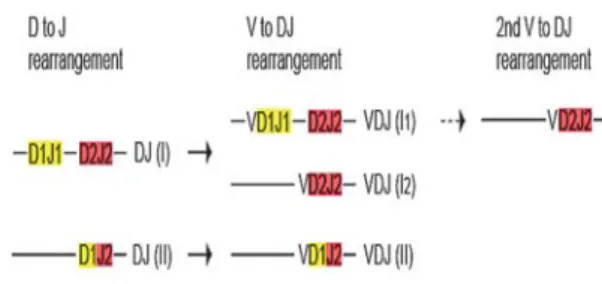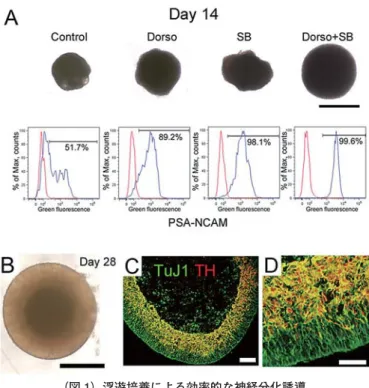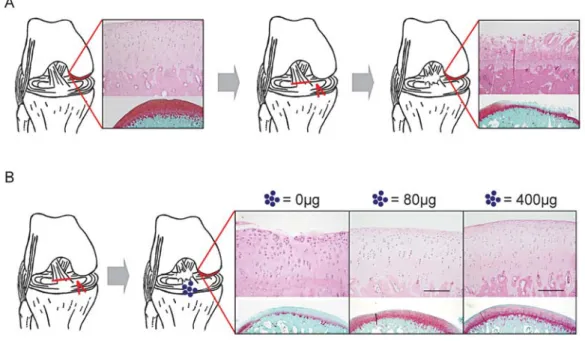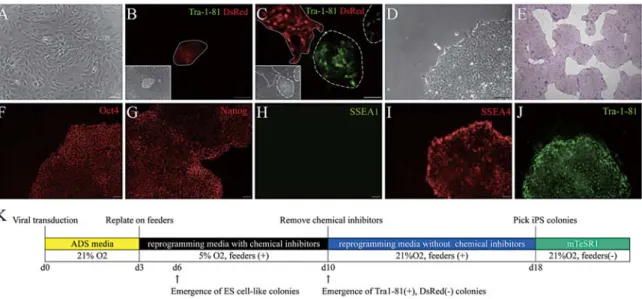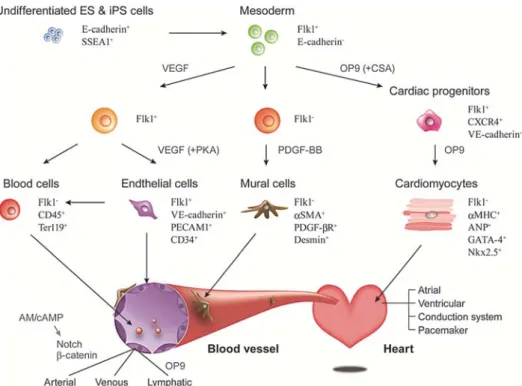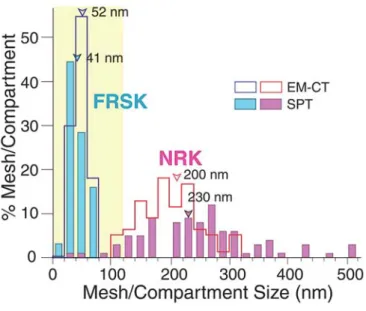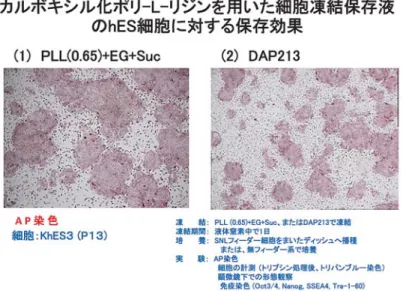Author(s)
Citation
京都大学再生医科学研究所年報 (2012), 14
Issue Date
2012-04-10
URL
http://hdl.handle.net/2433/155988
Right
Type
Research Paper
京 都 大 学
再生医科学研究所年報
Annual Report of the Institute for Frontier Medical Sciences
Kyoto University
〈第14巻〉
マウス体細胞は、Oct4, Sox2, Klf4 転写因子の一過的 強制発現により iPS 細胞に再プログラム化される。Sox2 の低レベル発現により高品質の iPS 細胞が出現する事実 を、蛋白質発現やキメラマウス作製能により証明した。キ メラ胚では iPS 細胞由来組織が青く染め出されている。 GFP, Green Fluorescence Protein; Nanog & Oct4, 未分 化細胞マーカー蛋白質
目 次
1
.巻 頭 言 ……… 12
.京都大学再生医科学研究所概要 2−1 沿 革 ……… 2 2−2 教員数等 ……… 2 (1)教 員 ……… 2 (2)大学院生・研修員・研究生等 ……… 2 2−3 組 織 図 ……… 33
.研究概要と研究業績 生 体 機 能 学 研 究 部 門 細 胞 機 能 調 節 学 分 野 (准 教 授 細川 暢子) …… 4 生 体 微 細 構 造 学 分 野 (講 師 平芳 一法) …… 10 生 体 機 能 調 節 学 分 野 (教 授 坂口 志文) …… 13 生 体 シ ス テ ム 制 御 学 分 野 (教 授 長澤 丘司) …… 19 生 体 組 織 工 学 研 究 部 門 生 体 分 子 設 計 学 分 野 (教 授 開 祐司) …… 24 生 体 材 料 学 分 野 (教 授 田畑 泰彦) …… 30 組 織 修 復 材 料 学 分 野 (教 授 岩田 博夫) …… 52 生 体 物 性 学 分 野 (客員教授 鳥光 慶一、佐藤 正明) …… 59 再 生 統 御 学 研 究 部 門 発 生 分 化 研 究 分 野 (教 授 中辻 憲夫) …… 70 再 生 増 殖 制 御 学 分 野 (教 授 瀬原 淳子) …… 76 再 生 免 疫 学 分 野 (助 教 藤本 真慈) …… 81 再 生 医 学 応 用 研 究 部 門 生 体 修 復 応 用 分 野 (准 教 授 高橋 淳) …… 84 組 織 再 生 応 用 分 野 (教 授 戸口田淳也) …… 89 器 官 形 成 応 用 分 野 (准 教 授 角 昭一郎) …… 95 臓 器 再 建 応 用 分 野 (准 教 授 中村 達雄) …… 99 附 属 再 生 実 験 動 物 施 設 (准 教 授 近藤 玄) …… 107 附属幹細胞医学研究センター 霊長類胚性幹細胞研究領域 (准 教 授 末盛 博文) …… 112 幹 細 胞 分 化 制 御 研 究 領 域 (准 教 授 山下 潤) …… 116 幹 細 胞 加 工 研 究 領 域 (准 教 授 多田 高) …… 125 細胞プロセシング研究領域 (客員教授 高橋 恒夫) …… 129 附属ナノ再生医工学研究センター ナノバイオプロセス研究領域 (教 授 楠見 明弘) …… 132 シミュレーション医工学研究領域 (准 教 授 玄 丞烋) …… 137 ナノバイオメカニズム研究領域 (助 教 都賀谷紀宏) …… 146 バイオメカニクス研究領域 (教 授 安達 泰治) …… 148 技 術 部 ……… 1564
.学 術 集 会 ……… 1575
.共 同 研 究 ……… 1636
.協議員・教職員・その他構成員名簿 ……… 1791
.巻 頭 言
昨年度末に死者と行方不明者を合わせて 20,629 人にもなる東日本大震災が発生しました。亡くなら れた方、また、関係者の方に心よりお悔やみ申し上げます。さらに、原子力発電所事故による放射性 物質による汚染が未だ続いており、泥炭の苦しみを舐めておられる皆様に心よりお見舞い申し上げま す。東日本大震災のニュースに接するたびに、 日常と変わらず研究していていいのだろうか、他に すべきことがあるのでは と悩まれた学生また研究者の方も多いと思います。この様な大変な年にも かかわらず、例年と同じように研究ができ、さらに、皆様へのご報告である研究所年報をお送りする ことができ、関係者の方々への感謝でいっぱいです。 さて、米アップル社のスティーブ・ジョブズ前最高経営責任者(CEO)が 56 歳で亡くなられまし た。米アップル社の斬新な PC の製品に接し、また、そのユーザーとしてその浮き沈みを同時代的に 経験してきた世代の者にとっては一際感慨深いものがあります。米アップル社は、独自の工場を持た ず、世界中の企業 150 社以上から部品調達し、さらに、組み立ても他社に委託して PC や iPhone を 製造しています。米アップル社の製品には Designed by Apple in California. Assembled in China な どと刻印されています。 大学の多くの研究室は、教育的な見地と研究費が限られていることもあり、出来る限り自前で実験 を行っています。見方によると我が京都大学は 1000 以上もの小企業の集まりのようです。基礎研究 はかなり個人の能力に依存するところがあるので、多少の弊害はあるものの決して悪い体制ではあり ません。しかし、多様な知識や技能を集積して達成しなければならない応用研究においては、大学の この体制は極めて非効率的です。PC と電話のある机にポツリと研究者一人がいる研究室もあってい いような気がします。この研究者が研究のデザインをして、実験は学内の優れた実験技術を有する多 数の研究室で分散的に実行され、その研究成果を研究のデザインをした研究者が取りまとめる。その 論文には Designed and Assembled by Dr. xx. Curried out in Kyoto University と刻印される。こ の様な研究体制もあってもいいのではないでしょうか。ここまで書いてきて、それは研究所長の仕事 だと気が付き、同時に個性豊かな研究所の先生方の顔が浮かんできました。来年度は研究所の総力を 注入し、世の中に多少なりとも還元できる研究成果を挙げるべく努力いたしますので、今後とも変わ らぬご支援をいただけますようよろしくお願いいたします。2
.京都大学再生医科学研究所概要
2 − 1 沿 革
本研究所は、平成 10 年 4 月 9 日に設置された。その前身である胸部疾患研究所は、昭和 16 年 3 月に「結核の予 防及び治療」を主軸とする結核研究所として設置され、昭和 42 年 6 月には結核胸部疾患研究所に名称変更、さらに 昭和 63 年 4 月には「胸部疾患に関する学理及びその応用の研究」を目的とした胸部疾患研究所への全面改組が行わ れたが、胸部疾患に関する研究・治療を取り巻く社会的要請の変化から、胸部疾患研究所は 57 年間にわたる使命を 終え、平成 10 年度より、同研究所基礎系分野及び臨床系分野の一部を人工臓器の研究・開発に関して顕著な業績を 挙げてきた生体医療工学研究センターと統合し、さらに実地臨床医学を行う医学研究科との協力により、「生体組織 及び臓器の再生に関する学理及びその応用の研究」を目的とする再生医科学研究所に改組・転換された。 改組・転換に伴い、胸部疾患研究所の臨床系分野の一部と研究所附属病院は、大学院医学研究科・医学部並びに 医学部附属病院へとそれぞれ引き継がれた。 本研究所は、平成 10 年 4 月の発足時は 5 大研究部門と附属再生実験動物施設で組織された。その後、平成 14 年 4 月に附属幹細胞医学研究センターが設置され、平成 16 年 4 月に研究部門の再編(1 大研究部門減)の実施により ナノ再生医工学研究センターが設置された。平成 16 年 10 月には、住友電気工業(株)の寄附による寄附研究部門 が 4 年間の時限で設置された。現在 4 大研究部門(生体機能学、生体組織工学、再生統御学、再生医学応用)、3 附 属施設となっている。平成 17 年 10 月から平成 22 年 3 月まで、工学研究科、医学研究科とともに、ナノメディシン 融合教育ユニットに参加した。 本研究所は、生命科学、医学、工学などの研究所が結集して再生医学の学際的基礎研究を推し進め、その成果の 医学応用をめざすとともに、ヒト ES 細胞株の樹立機関として、樹立・特性解析を行った ES 細胞を、全国の研究機 関へ分配するナショナルバイオリソース事業を実施している。 また平成 20 年 10 月には共同利用・共同研究拠点の認定を文部科学大臣より受け、再生医学・再生医療に関する 共同研究を実施している。 主な建物は、再生医科学研究所西館、再生医科学研究所東館(旧生体医療工学研究センター)、ES 細胞研究棟 (平成 14 年施工)、南部総合研究実験棟(ウイルス研、医学研究科との 3 部局合同使用)(平成 14 年施工)の 4 棟と なっている。2 − 2 教員数等
⑴ 教 員 (平成 24 年 1 月 1 日現在) 現 員 教 授 准教授 講 師 助 教 小 計 特任講師 特任助教 合 計 10(2) 13(1) 2 7 32(3) 1 2 35(3) ( )内は客員で外数 ⑵ 大学院生・研修員・研究生等 (平成 24 年 1 月 1 日現在) 大 学 院 生 研 修 員 研 究 生 外国人共同研究者等 98 6 8 42 − 3 組 織 図
(平成 24 年 1 月 1 日現在) 細胞機能調節学分野 生体微細構造学分野 生体機能調節学分野 生体システム制御学分野 生体再建学分野(国内客員) 生体分子設計学分野 生体材料学分野 組織修復材料学分野 生体物性学分野(国内客員) 発生分化研究分野 再生誘導研究分野 再生増殖制御学分野 再生免疫学分野 生体修復応用分野 組織再生応用分野 器官形成応用分野 臓器再建応用分野 再生医学応用流動分野 霊長類胚性幹細胞研究領域 幹細胞分化制御研究領域 幹細胞加工研究領域 細胞プロセシング研究領域 再プログラム化研究領域 ナノバイオプロセス研究領域 シミュレーション医工学研究領域 ナノバイオメカニズム研究領域 バイオメカニクス研究領域 再生医工学研究領域(外国人客員) 財務担当 総務担当 附属幹細胞医学研究センター 附属再生実験動物施設 所 長 教 授 会 協 議 員 会 副 所 長 運営委員会 研究部門 附属ナノ再生医工学研究センター 技 術 部 事 務 部 生命科学系キャリアパス形成ユニット 先端医工学研究ユニット 再生医学応用研究部門 再生統御学研究部門 生体組織工学研究部門 生体機能学研究部門3
.研究概要と研究業績
生体機能学研究部門
細胞機能調節学分野
Department of Molecular and Cellular Biology
准教授 細川 暢子
【研 究 概 要】
細胞機能調節学分野では、分子シャペロンタンパク質やレクチンの機能解析を中心に、再生現象の分子基盤とも 言うべきタンパク質の生合成・再生・品質管理の機構について研究を進めている。 細胞内で生合成されたタンパク質は、正しい高次構造を取ってはじめて機能することができる。タンパク質が正し い高次構造を形成するためには、分子シャペロンタンパク質の介助が必要であること、また生合成の過程でしばし ばタンパク質は高次構造形成に失敗する事が明らかになってきた。ミスフォールドしたタンパク質は、再度フォー ルディング・サイクルに入るか、場合によっては細胞内分解される必要がある。このように、正しい高次構造を もったタンパク質を生合成・再生し、ミスフォールドしたタンパク質を処理するメカニズムは、タンパク質の品質 管理機構と呼ばれている。小胞体では、多くの分泌タンパク質や膜タンパク質の生合成が行われており、これらの タンパク質の高次構造形成は小胞体品質管理機構(ERQC: endoplasmic reticulum quality control)によって担われ ている。小胞体内でミスフォールドしたタンパク質はサイトゾルへ引き出された後、ユビキチン - プロテアソーム 系で分解され、小胞体関連分解(ERAD: endoplasmic reticulum-associated degradation)と呼ばれている。私たち は、ERQC および ERAD の作用機序の解明を、細胞、分子ならびに個体レベルで行っている。このメカニズムは、 遺伝子レベルで変異をもったタンパク質が ERAD 機構によって分解されたり、あるいは ERQC の破綻が糖尿病や 神経変性疾患などさまざまな疾患を引き起こすことが明らかにされ、病態解明や疾病治療の面からも注目されてい る。また、小胞体で生合成されるタンパク質の多くは 結合型糖鎖をもった糖タンパク質であり、従って小胞体品 質管理においては、糖鎖のトリミングと、特定の構造をもった糖鎖を認識するレクチンが、タンパク質のフォール ディングや分解を制御することが知られている。 私たちは、哺乳類小胞体に存在する分子シャペロンタンパク質やレクチン、酵素、小胞体膜上に存在するユビキ チンリガーゼ複合体などのタンパク質品質管理に関わる分子を中心に研究を進めている。小胞体関連分解を促進す る EDEM タンパク質(endoplasmic reticulum degradation enhancing α-mannosidase-like protein)や、新規 ERAD レクチン OS-9 と XTP3-B、HRD1-SEL1L ユビキチンリガーゼ複合体の機能解析を行い、糖タンパク質のもつ糖鎖 構造とこれを認識するレクチンを明らかにした。また、小胞体膜上の ERAD 複合体の解析を行った結果、動的な調 節を受けている可能性が示された。さらに現在、小胞体ストレスで発現誘導を受ける新たな遺伝子の機能解析につ いても研究を進めている。The major focus in the Department of Molecular and Cellular Biology is to study the regulation and function of molecular chaperones/stress proteins and lectins, and the mechanism of protein quality control.
Newly synthesized proteins obtain their native conformations by the assistance of molecular chaperones. However, the process of protein folding is error-prone, and polypeptides that failed to obtain native structures enter the refolding cycle or are subjected to intracellular protein degradation. Many secretory proteins and membrane proteins are synthesized in the endoplasmic reticulum(ER), and their folding is regulated by the ER quality control(ERQC). Terminally misfolded polypeptides in the ER are degraded by the cytoplasmic proteasomes after retrotlanslocation through the ER membrane, a mechanism known as ER-associated degradation(ERAD). Many works have clarified the importance of ERAD of misfolded proteins and the disruption of ERQC in genetic diseases, neurodegenerative disorders, and diabetes mellitus. Since most of the proteins synthesized in the ER are -glycosylated, ERQC of glycoproteins are regulated by the processing of the -glycans and the recognition of specific -glycans by the lectins.
We are analyzing the function of mammalian EDEMs(ER degradation enhancing α-mannosidase-like proteins), ERAD lectins OS-9 and XTP3-B, and HRD1-SEL1L ubiquitin-ligase complex embedded in the ER membrane. Recently, we clarified the -glycan structures that are used as the glycan-tags for the glycoprotein ERAD, as well as lectins that recognize the ERAD signals. We also analyzed the ERAD complex containing HRD1-SEL1L in the ER membrane, and found that the formation of ERAD complex is dynamically regulated. Analyses
小胞体膜上に存在する ERAD 複合体
小胞体膜にはユビキチンリガーゼ(E3)が存在し、小胞体でミスフォールドしたタンパク質をユビキチン化し、プロテアソーム による分解へと導く。リングドメインを持つユビキチンリガーゼ HRD1 は SEL1L と結合し、HRD1-SEL1L を中心として大きな ERAD 複合体が形成される。ERAD 複合体の形成、機能は、ダイナミックな制御を受けている。
ERAD complex on the ER membrane
Ubiquitin ligases (E3 enzymes) embedded in the ER membrane ubiquitinate misfolded ER proteins for proteasomal degradation. HRD1 is a ubiquitin ligase containing a ring-domain, and makes a stoichiometric compelx with SEL1L. ERAD complexes are dynamically formed in the ER membrane nucleated on the HED1-SEL1L complex to regulate the protein degradation.
on proteins that are upregulated by ER stress are also underway. (文責 細川 暢子) 小胞体内で発生するタンパク質凝集メカニズムの研究に従事している。現在のところ研究対象とするアンチ トリプシン欠損症は、遺伝性タンパク質凝集疾患の一つとして特に欧米で患者が多く(有名な Z 変異は 4% が heterozygote、0.1% が homozygote で保持)、早急な疾病メカニズムの解明、治療法の開発が待たれている。本疾患 は患者の肝細胞、特に小胞体内にアンチトリプシン封入体の蓄積がみられることを特徴とする。その結果引き起こ される典型的な病態として肝機能の不全が挙げられ、また同時に血中へのアンチトリプシン分泌量が低下すること にから、エラスターゼ阻害未遂による肺気腫を引き起こすことが知られている。まず、試験官内で誘導できるアン チトリプシン凝集体形成機構について、X 線結晶構造解析をベースとし検討を行なったところ、アンチトリプシン は単一のタンパク質でありながら、条件によって図に示したような 2 種類の凝集メカニズムが可能であることが明 らかとなった(A:分子中央の構造モチーフが隣の分子に挿入、B:分子 C 末が挿入)。各分子はまるでパズルを完 成するごとく、その分子構造の一部を隣の分子と共有することで規則正しい凝集体形成を実現しており、これは現 在までの漠然としたタンパク質凝集のイメージ、例えば「異常な」と称される、とはずいぶん異なるものであった。 次に、これら 2 種の凝集メカニズムの発生を区別できる SS 結合変異体システムを構築し、アンチトリプシン欠損症 で最も多い Z 変異体が、酵母、ほ乳類細胞においてどのように凝集を行なうかを検討した。結果、B が主要なメカ 図 アンチトリプシンの天然構造と 2 種類のポリマー構造 アンチトリプシンは分子中央の赤で示された β̶シートとセリンプロテアーゼインヒビターとしての機能に重要な黄色で示され た反応中心ループを特徴とする(Monomer)。グアニジン塩酸条件下では、アンチトリプシンはその反応中心ループと β シートの 一部が隣の分子に挿入し、分子間フォールディングを完成した、ポリマー構造を完成する(Polymer A)。一方で、熱条件下では、 水色で示された分子の C 末部分を隣の分子の背中の β シートに挿入し、ポリマー構造を完成する。なお、アンチトリプシン欠損 症の患者には Polymer B のメカニズムにより凝集体が蓄積するようである。
Figure the native and two different polymer structures of α1-antitrypsin
α1-antitrypsin has very characteristic structural components such as the central β-sheet A shown in red and the reactive center loop shown in yellow, both of which are of great importance in its potent function that can inhibit serine proteases(Monomer). Under a denaturant condition like in the presence of Guanidine Hydrochloride, α1-antitrypsin can complete molecular linkage by inserting the reactive center loop and the part of b-strand into the central β-sheet A(polymer A). We call this as an intermolecular folding. On the other hand, under a heat condition, α1-antitrypsin can finish polymerization via a linkage of C-terminal part of the molecule shown in cyan(polymer B). In this case, the reactive center loop is incorporated into the original molecule yet still gain an energetic advantage as a protomer conformation. As a molecular basis of α1-antitrypsin deficiency, polymer B is very likely a toxic aggregation on diseases.
ニズムと判明した。最終的には、2 種の凝集メカニズムを区別できる抗体を入手し、実際に肝硬変を患った方々由 来の凝集体についても検討を行ったが、結果は同じであった。以上から、アンチトリプシン欠損症の分子基盤は、Z 変異がアンチトリプシンの天然構造への迅速なフォールディングを妨げ、分子の C 末部分を露出したフォールディ ング中間体の蓄積が小胞体内で起こった結果、分子間でフォールディングを完成して凝集体形成に至ることにある と予測された。また構造学的には、凝集に際し分子中央の β シートを形成するストランドの数が天然構造における 5 本から 6 本へ拡張していることは、凝集体形成が熱力学的に好まれることを示唆しており、本疾患で Z 変異体が 細胞内に不可逆的に凝集、蓄積する理由として妥当である。一方で、正常なアンチトリプシンのフォールディング においては、このように熱力学的に好ましいと思われる凝集体の形成を、小胞体の品質管理機構がいかにして回避 しアンチトリプシンを天然構造へと導いているのかが興味深いところである。以上の研究成果は、私が 2011 年 4 月 まで在籍した英国ケンブリッジ大学の James Huntington 研究室との共同研究による。感謝申し上げたい。
I am studying a mechanism for protein aggregation in ER. The current interest has been an underlying molecular mechanism for the α1-antitrypsin deficiency that is very popular as one of the protein aggregation related diseases especially in North Europe(4% is heterozygote and 0.1% is homozygote in Caucasian)and would be applicable to prevent or treat this deficiency. α1-antitrypsin deficiency is typically characterized by the intracellular deposition of the α1-antitrypsin aggregates and inclusion bodies in patient hepatocyte. This seems to be a direct cause for the juvenile cirrhosis and alternatively the emphysema due to the lack of the secreted α1-antitrypsin in plasma that inhibits a neutrophil elastase. With a great help by James Huntington s laboratory where I had belonged to until the April 2011, we first examined how α1-antitrypsin can polymerize
on the basis of X-ray crystallographic techniques. We found α1-antitrypsin can polymerize via two distinct mechanisms depends on conditions, but both occur structurally in a very similar manner. It seems like a protein puzzle that each protein shares structural components to form a protomer unit; polymer A uses the motif in the central β-sheet A for molecular linkage and polymer B uses in the C-terminal part of the molecule. Moreover, the structure of the polymer very resembles to the native monomer α1-antitrypsin, which was indeed a surprise for us contrary to the general assumption we had for the way of protein aggregation like abnormal . Secondary, we developed the method to distinguish these aggregation mechanisms by introducing SS trapping techniques and evaluated how the most abundant mutant Z α1-antitrypsin behaves on aggregation in yeast and mammalian cell systems. The result clearly showed polymer B was dominant in both systems. Finally we also confirmed that polymer B was accumulated in the liver inclusions from the Z-α1-antitrypsin patient by using a monoclonal antibody that is also sensitive to distinguish the mechanisms. Collectively, it was concluded that the formation of polymer B would be a major cause for α1-antitrypsin deficiency. We also deduced that Z mutation disturbs the correct folding of α1-antitrypsin in the ER and accumulates the folding intermediate, where C-terminal part of the molecule may be exposed, and thereby α1-antitrypsin had to complete its folding by sharing structural components between molecules. From the structural point of view, it is interesting to mention α1-antitrypsin does b-expansion in the central β-sheet A from 5 to 6 strands on aggregation. This indicates the formation of aggregates would be energetically preferred and it is thus consistent with observation that Z-mutant aggregate and further accumulate irreversibly. Now, it is also curious how the ER quality control bypass this energetically favorable event on the normal folding of α1-antitrypsin. I really acknowledge Dr. Jams Huntington and his colleagues to
accomplish the above studies.
(文責 山 正幸 特定准教授(白眉)(兼任 次世代研究者育成センター))
【業 績 目 録】
▣
誌上発表
▣
(1)原著論文
Iida, Y., Fujimori, T., Okawa, K., Nagata, K., Wada, I., and Hosokawa, N.*: SEL1L protein critically determines the stability of the HRD1-SEL1L endoplasmic reticulum-associated degradation(ERAD)complex to optimize the degradation kinetics of ERAD substrates. .: 286, 16929-16939(2011)
Yamasaki, M., Sendall, T., Pearce, M., Whisstock, J., Huntington, J.: Molecular basis of α1-antitrypsin deficiency revealed by the structure of a domain-swapped trimer. : 30, 1011-1017(2011).
(2)著書および総説
細川暢子:[ みにれびゅう ] ERAD(小胞体関連分解)を制御するレクチン OS-9 と XTP3-B 生化学、第 83 巻 第 1 号、44-49(2011)
Hosokawa, N.: Isolation and binding assay of EDEMs. GlycoPOD web site(Ed. T. Kawasaki): <9>-9(2011) Huntington, J., Yamasaki, M.: Serpin polymerization in vitro. . : 501, 379-420(2011).
▣
学会等の発表
▣
(1)学会・研究会発会Fujimori, T., Kamiya, Y., Kato, K., Nagata, K., Hosokawa, N.: Functional analysis of MRH domain-containing lectin XTP3-B in the endoplasmic reticulum quality control. The 31st Naito Conference on Glycan Expression and Regulation [II] Metabolites, Stress response, Microdomains, and Beyond.(2011.9.13-16 Sapporo)(ポスター 発表)
Fujimori, T., Kamiya, Y., Kato, K., Nagata, K., Hosokawa, N.: The novel role of MRH domain-containing lectin XTP3-B in endoplasmic reticulum quality control. 第 34 回日本分子生物学会年会(2011.12.13-16 横浜)(口 頭及びポスター発表)
藤森力 , 神谷由紀子 , 加藤晃一 , 永田和宏 , 細川暢子 : 小胞体品質管理におけるレクチン XTP3-B の新たな役割 . 平成 23 年度京都大学再生医科学研究所学術講演会(2011.12.26 京都)(ポスター発表)
Yamasaki, M., Timothy J. Sendall, T. J., Mary C. Pearce, M. C., Whisstock, J. A., Huntington, J. A.:The Molecular Basis of α1-Antitrypsin Deficiency. 第 34 回日本分子生物学学会年会(2011.12.13-16 横浜)(口頭発表及びポ スター)
山 正幸:先天性肝硬変の原因となる凝集体構造 . 平成 23 年京都大学再生医科学研究所学術講演会(2011.12.26 京 都)(ポスター発表)
(2)講演・シンポジウム
Hosokawa, N.: Lectins and enzymes that regulate the mammalian glycoprotein quality control.: The 31st Naito Conference on Glycan Expression and Regulation [II] Metabolites, Stress response, Microdomains, and Beyond.(2011.9.13-16 Sapporo)
細川暢子:小胞体における糖鎖修飾とタンパク質品質管理機構 . 第 84 回日本生化学会大会シンポジウム「糖鎖修 飾:システムズバイオロジーへの展望」(2011.9.22 京都)
Hosokawa, N.: Roles of -glycans in the regulation of mammalian glycoprotein quality control. 第 34 回日本分子生 物学会年会シンポジウム Glycoprotein quality control: Biosynthesis, molecular recognition and physiological roles of -glycans (2011.12.16 横浜) 山 正幸:Point mutation が引き起こす小胞体でのタンパク質凝集とその病変 . 大阪大学蛋白質研究所セミナー 「蛋白質の異常凝集の原理と制御」(2011.4.27 吹田) 山 正幸:「分子間フォールディング」によるタンパク質のポリマー化 . 第 11 回日本蛋白質科学会年会(2011.6.7-9 吹田) 山 正幸:小胞体内におけるタンパク質の規則正しい凝集とその疾患 . 第 2 回生命機能研究会(2011.8.31 神戸) 山 正幸:我々にとって有害なタンパク質構造とは? 栄養学をはんなりと研究する会(2011.9.10 名古屋) Yamasaki, M., Sendall, T. J., Mary C. Pearce, M. J., Whisstock, J. A., Huntington, J. A.: The Molecular Basis of
α1-Antitrypsin Deficiency. The 6th International Symposium on the Chemistry and Biology of Serpins
生体微細構造学分野
Department of Ultrastructural Research
講師 平芳 一法
【研 究 概 要】
ショウジョウバエの発生やストレス応答などに関与する遺伝子の多くは、GAGA 因子依存的遺伝子として知られ ている。GAGA 因子は、転写制御領域に存在する GAGA 配列に特異的に結合し、クロマチンリモデリングに必要 な因子をリクルートするとともに、転写活性そのものへの関与等、広範な機能が示唆されている。また、ストレス 蛋白質では、転写伸長開始直後に転写を一旦停止するポーズドポリメラーゼという現象が知られているが、GAGA 因子は、このポーズドポリメラーゼの成立に関与する重要な因子と認識されている。つまり、GAGA 因子は、転写、 特に伸長反応を考える上で重要な因子と考えられる。この因子の生体内における機能を明らかにするため、GAGA 因子特異的な RNA アプタマーを取得し、詳細な解析を続けている。 我々が選別・取得した RNA アプタマー(蛋白質に特異的に結合する機能性 RNA)は、他の因子あるいは自己の 重合化に関与する POZ ドメインを中心とした領域に結合し、転写を阻害する。転写複合体は、複数の因子によって 成立し、因子間のコミュニケーションによって高度な制御がなされている。つまり、アプタマーによる転写阻害は、 転写複合体中の GAGA 因子を介した複合体の形成因子間の関係を齟齬にすることにより、生じたものと思われる。 すでに取得していた主要な基本転写因子である TBP(TATA binding protein)に対するアプタマーを併用した解 析により、GAGA 因子が、TBP の転写複合体上へのリクルートにも関与していることを明らかにした。昨年、GAGA 配列に変異を導入し、GAGA 因子が DNA に直接結合できない GAGA 因子依存的な遺伝子でも GAGA 因子がその転写複合体中に含まれる可能性を報告した。本年は、転写複合体を回収した後、免疫学的な方法 で実際に含まれていることを証明し、GAGA 因子依存的な遺伝子における、GAGA 因子の作用機作の新しい局面を 明らかにした。 RNA アプタマーそのものの活用方法として、異なる結合領域を持つアプタマーを一つの分子として機能させる ことにより、抗体とは異なるユニークな活用方法を示した。この方法は、細胞内で、本来結合することができない 分子を任意に結合させることができる。この分子を用いれば、人工的な複合体を細胞内で構築することも可能にな る。また、RNA を利用した分子故に、生体内では一定時間で分解される。これらの特徴を生かし、必要なときにの み働く、副作用の少ない薬剤として活用することも可能であり、近年注目されている抗体医薬と同等あるいはそれ 以上の機能が期待される。RNA アプタマーの活用方法を模索している。
Many genes respond to development or stress response in Drosophila is known as GAGA factor(GAF) dependent gene. GAF binds to GAGA element in the promoter and recruits chromatin remodeling factors. It has been reported that this factor involves a nucleosome remodeling at promoter region, a formation of promoter proximal pausing of RNA polymerase II, and the transcription elongation. To analyze the role of GAF in the transcription complex precisely, we use RNA aptamers as molecular forceps. We obtained two kinds of aptamer which bind to GAF with a high affinity. These aptamers bound to the POZ domain of GAF, where is critical
for the protein-protein interaction, but not to the zinc finger and the glutamine rich domain. These aptamers inhibited the transcription with the naked DNA as a template. One aptamer showed the inhibitory effects on the transcription from the promoters containing GAGA elements when adding the aptamer before the transcription initiation. The other showed the inhibitions after the transcription initiation. The effect of this aptamer was independent of whether the presence or absence of the GAGA element at the promoter region. However this effect was observed only on the transcription from the GAF-dependent promoter, not from the GAF-independent promoter.
We showed the direct evidence to suggest the presence of GAF in the transcription complex of GAF dependent gene by the isolation of transcription complex.
These results suggest the functions of GAF in initiation, elongation or re-initiation steps via the interaction
GAGA 因子依存性転写制御領域における GAGA 因子の存在
試験内転写の結果 GAF が GAF 依存性遺伝子の転写瀬魚領域において、GAGA 配列非依存的に存在することが示唆されたため、 その可能性を固相 DNA 蛋白質複合体を用いて解析した。
ビオチン化した DNA(GAF 依存性、非依存性転写制御領域)を磁気ビーズに結合した。この DNA とショウジョウバエ胚抽出液 あるいは組み換え His 標識 GAF を混合、洗浄後、免疫ブロッティング法で解析した。Hsp70 転写制御領域では、胚抽出液、組み 換え GAF 共に GAF の存在が確認された。GAF 非依存性の Copia では胚抽出液、組み換え GAF 共にバックグラウンド程度のシ グナルしか観察されず、結合は認められない。Hsp70 転写制御領域の GAGA 結合領域を欠損した mmGAGA 遺伝子では胚抽出液 では、Hsp70 の半分程度の GAF の存在が観察された。しかし、組み換え GAF ではバックグラウンド程度のシグナルしか観察さ れず、結合は認められなかった。これは、GAF は mmGAGA 遺伝子では、GAGA 配列に直接結合するのではなく、複合体に含ま れた形で、GAF 依存性遺伝子の転写制御領域に取り込まれていることを示すものである。
The presence of GAF on the GAF-dependent promoter
The results of the in vitro transcription suggest the presence of GAF on the GAF-dependent promoter with the DNA independent manner. To check this possibility, we tried to the solid-phase DNA-protein complex assay.
Biotynilated DNA(GAf dependent, independent promoter)was attached on the magnetic beads. This template was incubated with the Fly embryo extract(FEE)or recombinant His-tagged GAF. After washing the beads, proteins on the DNA were analyzed by the western blotting.
As shown above, GAF in FEE was on the hsp70 promoter, and a little amount of GAF, as the same level as the background, was on the Copia promoter. Hsp70 mmGAGA gene involved the GAF in the protein complex. The intensity of the signal on the mmGAGA was as about half as that on hsp70 gene, but clearly stronger than that on Copia gene. On the other hand, His-GAF did not bind to mmGAGA promoter. This result suggests that GAF is on the mmGAGA DNA. These result suggests that GAF is present only on the GAF dependent genes by not only binding to the GAGA element but also interacting with other factor(s) in the transcription apparatus.
with other factors in the transcription apparatus, which imply the importance of GAF as a regulator throughout the whole process of transcription
RNA aptamer is expected as a substituent of antibody therapy. We succeeded to establish the multi-recognition molecule that recognizes the different molecule. To expand the application of RNA aptamer as a cure drug or examination reagent, we tried to establish the construct protocol for more effective aptamers.
【業 績 目 録】
▣
学会等の発表
▣
学会発表法邑 賢一・平芳 一法:PIC 形成過程における TBP/GAF 間相互作用の役割 第 34 回日本分子生物学会物学会年 会、(2011.12.13. ∼ 16. 横浜)
生体機能調節学分野
Department of Experimental Pathology
分野主任 教授 坂口 志文
【研 究 概 要】
(1)免疫寛容の基礎的研究 正常な免疫系は、非自己抗原に対して免疫応答を示すが、正常自己構成成分に対しては反応しない。また、アレル ギーに見られる過剰な免疫応答を阻止する機構を有している。このような免疫自己寛容、免疫恒常性維持の基礎的 メカニズムとして、制御性 T 細胞による抑制的制御が重要である。その機能異常は自己免疫病、アレルギーの原因 となる。制御性 T 細胞は転写因子 Foxp3 を特異的に発現するが、機能、表現型の安定性を保つためには epigenetic な変化が必要である。本年度、制御性 T 細胞の発生・分化における epigenetic 変化を解析した。Methylated DNA immunoprecipitation sequencing(MeDIP-Seq)および Bisulfite sequencing 法により DNA メチル化状態をグロー バルにまた特定の遺伝子について解析した。その結果、制御性 T 細胞に特徴的に発現し機能に必須の遺伝子(例え ば、Foxp3, CTLA-4, GITR, Eos, Helios, CD25)の CpG 脱メチル化が安定な制御性 T 細胞の発生、機能維持に重要 であること、制御性 T 細胞の細胞系譜の決定には、これらの遺伝子の脱メチル化が、Foxp3 遺伝子の発現と独立し て必要であることを見出した。また、胸腺での制御性 T 細胞の発生には、自己抗原の認識による T 細胞抗原レセプ ターを介した刺激が、Foxp3 遺伝子の発現と制御性 T 細胞機能関連遺伝子の脱メチル化の両方に不可欠であること を見出した。これらの知見は、機能的に安定な制御性 T 細胞の作製によるヒト免疫応答の制御に重要である。 (2)自己免疫、腫瘍免疫、移植免疫の基礎的研究 ヒト疾患における制御性 T 細胞の役割について研究を継続した。本邦に多い成人 T 細胞白血病・リンパ腫(adult T cell leukemia/lymphoma)の多くは Foxp3 を発現し、制御性 T 細胞が腫瘍化したものである可能性について解 析を進めた。さらに、ATLL 細胞に発現する腫瘍抗原を検索するべく、患者血清を用いて、Seromics による網羅 的蛋白アレイを行ったところ、多くの患者血清中に、がん―精巣抗原(Cancer-testis(CT)antigen)に対する抗 体が出現していることを見出した。NY-ESO-1 などの CT 抗原は、ほかのヒト癌組織にも発現しているが 80%以上 の ATLL 細胞にも発現していた。CT 抗原は、他の白血病細胞には発現しておらず、極めて ATLL に特徴的であ る。また、患者リンパ球には、CT 抗原に反応し、サイトカインを産生する T 細胞も検出できた。これらの結果は、 ATLL に対して、CT 抗原ワクチンによる免疫療法が有効である可能性を意味する。 (3)新しい動物モデルを用いた関節リウマチの原因・発症機構の研究 SKG マウスは、免疫病理学的にヒトの関節リウマチと酷似する慢性関節炎を自然発症する。その原因遺伝子は、 T 細胞抗原レセプター(T cell receptor, TCR)直下に位置するシグナル分子である ZAP-70 であり、その SH2 ドメ インの一塩基変異によって関節炎が誘導される。本年度、ZAP-70 遺伝子の変異のみならず、TCR 直下のどのよう なシグナル分子であっても、TCR シグナルを一定程度弱化すれば自己免疫性関節炎が誘導できる可能性について検 討した。Tet-on システムにより正常な ZAP-70 遺伝子をトランスジェニックマウスとして発現し、内因性 ZAP-70を欠損するマウスを作製した。餌に含まれる Doxycycline(Dox)量を変えることで ZAP-70 分子の発現量を調節し た。その結果、低濃度 Dox の餌で維持したマウスは高率に関節炎を発症したが、高濃度の餌では発症しなかった。 関節炎のみならず、高率に間質性肺炎、また一部に炎症性腸炎の発症が見られた。発症した病変は T 細胞によって 他のマウスに移入可能なことから、これらの病変は自己反応性 T 細胞による自己免疫病であることが証明された。 この結果は、TCR 近傍の様々なシグナル分子の機能変異によって自己免疫病の誘導が可能であることを意味する。 実際、ヒトのゲノム相関解析(genome-wide association study, GWAS)で、ZAP-70 と相互作用するシグナル分子 の変異が報告されており、我々の実験結果は、ヒトの自己免疫疾患の理解に重要と考える。
This department studies:(i)the cellular and molecular basis of immunologic self-tolerance and the etio-pathology of autoimmune disease;(ii)the strategy for eliciting effective immune responses to autologous tumor cells, or inducing immunologic tolerance to organ transplants, by manipulating the mechanism of immunologic self-tolerance; and(iii)the cause and pathogenetic mechanism of rheumatoid arthritis by utilizing an animal model established in our laboratory.
One aspect of immunologic self-tolerance(i.e., immunological unresponsiveness of the normal immune system to normal self-constituents)is actively maintained through a T cell-mediated dominant control of self-reactive T cells by naturally occurring regulatory CD4+ T cells(Tregs). We previously showed that the transcription factor
Foxp3 is a master regulator of their development and function.
This year, we have attempted to understand the molecular mechanism by which the cell fate of Tregs is determined. We have shown that Treg development is achieved by the combination of two independent processes, , the expression of Foxp3 and the establishment of Treg-type CpG hypomethylation, both induced by TCR stimulation. The demethylation began in the thymus and continued to proceed in the periphery, and could be fully established without Foxp3 protein. Either Foxp3 expression or Treg-type hypomethylation alone was insufficient for establishing full Treg phenotype and function. Thus, those T cells in which the two events have concurrently occurred as a result of TCR stimulation are developmentally set into the Treg lineage. These findings can be exploited for constructing functionally stable Treg cells for clinical use.
Adult T-cell leukemia/lymphoma(ATLL)is an intractable hematologic malignancy caused by human T-lymphotropic virus type 1(HTLV-1), which infects approximately 20 million people worldwide. This year, we have explored the possible expression of cancer/testis(CT)antigens by ATLL cells, as CT antigens are widely recognized as ideal targets of cancer immunotherapy against solid tumors. We found that a high percentage(more than 80%)of ATLL cases expressed CT antigens at the mRNA level. CT antigen expression was confirmed by immunohistochemistry. This contrasts with other types of lymphoma or leukemia, which scarcely express these CT antigens. Humoral immune responses, particularly against NY-ESO-1, were detected in 10% of ATLL patients and NY-ESO-1-specific CD8+ T cell responses were observed in more than half of ATLL patients.
NY-ESO-1-specific CD8+ T cells recognized autologous ATLL cells and produced effector cytokines. Thus, ATLL
cells characteristically express CT antigens and therefore vaccination with CT antigens can be an effective immunotherapy of ATLL.
SKG mentioned spontaneously develop T cell-mediated autoimmune arthritis immunopathologically similar to rheumatoid arthritis(RA)in humans. This year, we have attempted to determine how T cell receptor(TCR)
signaling controls immunological self-tolerance and homeostasis. We gradationally expressed zeta-associated protein-70(ZAP-70), a TCR-proximal signaling molecule, in developing T cells by tetracycline-inducible gene expression. As a result of the experiments, T cells produced in a low range of ZAP-70 expression were highly self-reactive and contained few natural regulatory T(Treg)cells, leading to spontaneous development of a variety of autoimmune and immunopathological diseases including autoimmune arthritis and inflammatory bowel disease. Increase in ZAP-70 expression inhibited disease development by facilitating negative selection of pathogenic self-reactive T cells, positive selection of less self-reactive ones, and the generation of natural Treg cells. Thus, reduction of TCR-proximal signaling in developing T cells evokes autoimmune/inflammatory diseases and normalization of the signaling prevents them. This finding will help our understanding how genetic variations in TCR signaling molecules contribute to the development of autoimmune disease such as rheumatoid arthritis.
【業 績 目 録】
▣
誌上発表
▣
1)原著論文
Sakaguchi, S., Powrie, F., Ransohoff, R. M. Re-establishing immunological self-tolerance in autoimmune disease. In press.
Wing, K., Yamaguchi, T., Sakaguchi, S. Cell-autonomous and ‒nonautonomous functions of CTLA-4 for negative control of immune responses. 32:428-433, 2011.
Sakaguchi, S., Wing K. Damping by depletion. 332:542-543, 2011.
Ohkura, N., Sakaguchi, S. Maturation of effector regulatory T cells. 12:283-284, 2011.
Yoshioka, Y., Ono, M., Osaki, M., Konishi, I., Sakaguchi, S. Differential effects of inhibition of bone morphogenic protein(BMP)signalling on T-cell activation and differentiation. In press.
Keith, R. C., Powers, J. L., Redente, E. F., Sergew, A., Martin, R. J., Gizinski, A., Holers, V. M., Sakaguchi, S., Riches, D. W. A Novel Model of Rheumatoid Arthritis-Associated Interstitial Lung Disease in SKG Mice.
In press.
Ohe, H., Waki, K., Yoshitomi, M., Morimoto, T., Nafady-Hego, H., Satoda, N., Li, Y., Zhao, X., Sakaguchi, S., Uemoto, S., Bishop, G. A., Koshiba, T. Factors affecting operational tolerance after pediatric living-donor liver transplantation: impact of early post-transplant events and HLA match. 25:97-106, 2012. Sinclair, C., Saini, M., van der Loeff, I. S., Sakaguchi, S., Seddon, B. The long-term survival potential of mature T
lymphocytes is programmed during development in the thymus. 4(199):ra77, 2011.
Yamaguchi, T., Wing, J. B., Sakaguchi, S. Two modes of immune suppression by Foxp3(+)regulatory T cells under inflammatory or non-inflammatory conditions. 23:424-430, 2011.
Sakaguchi, S., Tanaka, S., Tanaka, A., Ito, Y., Maeda, S., Sakaguchi, N., Hashimoto, M. Thymus, innate immunity and autoimmune arthritis: interplay of gene and environment. 585:3633-3639, 2011.
Wing, J. B., Sakaguchi, S. TCR diversity and Treg cells, sometimes more is more. 41:3097-3100, 2011.
pharmacological agents. 32:158-66, 2011.
Keller, K. K., Stengaard-Pedersen, K., Dagnæs-Hansen, F., Nyengaard, J. R., Sakaguchi, S., Hauge, E. M. Histological changes in chronic autoimmune SKG-arthritis evaluated by quantitative three-dimensional stereological
estimators. 29:536-43, 2011.
Sakaguchi, S., Sakaguchi, N., Asano, M., Itoh, M., Toda, M. Pillars Article: Immunologic Self-Tolerance Maintained by Activated T Cells Expressing IL-2 Receptor α-Chains(CD25). Breakdown of a Single Mechanism of Self-Tolerance Causes Various Autoimmune Diseases. 1995. 155: 1151-1164. 186:3808-21, 2011.
Ohe, H., Li, Y., Nafady-Hego, H., Kayo, W., Sakaguchi, S., Wood, K., Calne, R., Uemoto, S., Koshiba, T. Minimal but essential doses of immunosuppression: A more realistic approach to improve long-term outcomes for pediatric living-donor liver transplantation. 91:808-810, 2011.
Satou, Y., Yasunaga, J., Zhao, T., Yoshida, M., Miyazato, P., Takai, K., Shimizu, K., Ohshima, K., Green, P. L., Ohkura, N., Yamaguchi, T., Ono, M., Sakaguchi, S., Matsuoka, M. HTLV-1 bZIP factor induces T-cell lymphoma and systemic inflammation in vivo. 7(2):e1001274, 2011.
Miyara, M., Gorochov, G., Ehrenstein, M., Musset, L., Sakaguchi, S., Amoura, Z. Human FoxP3(+)regulatory T cells in systemic autoimmune diseases. In press.
Miyara, M., and Sakaguchi, S. FoxP3+CD4+ regulatory T cells: their knowns and unknowns. 89(3):346-51, 2011.
Kurotaki, D., Kon, S., Bae, K., Ito, K., Matsui, Y., Nakayama, Y., Kanayama, M., Kimura, C., Narita, Y., Nishimura, T., Iwabuchi, K., Mack, M., van Rooijen, N., Sakaguchi, S., Uede, T., and Morimoto, J. CSF-1-dependent red pulp macrophages regulate CD4 T cell responses. 186:2229-2237, 2011.
Peterson, L. K., Shaw, L. A., Joetham, A., Sakaguchi, S., Gelfand, E. W.,and Dragone, L. L. SLAP Deficiency Enhances Number and Function of Tregs Preventing Chronic Autoimmune Arthritis in SKG Mice.
186:2273-81, 2011.
Côté, A. L., Zhang, P., O'Sullivan, J. A., Jacobs, V. L., Clemis, C. R., Sakaguchi, S., Guevara-Patiño, J. A., and Turk, M. J. Stimulation of the glucocorticoid- induced TNF receptor family-related receptor on CD8 T cells induces protective and high-avidity T cell responses to tumor-specific antigens. 186:275-83, 2011. Sakaguchi, S. Regulatory T cells: history and perspective. 77: 1-13, 2011.
2)総説
濱口真英、坂口志文:Foxp3+制御性 T 細胞による炎症制御 実験医学 Vol.29 No.10(40-45)2011
橋本 求、坂口志文:補体活性化産物 C5a による Th17 細胞の誘導 臨床免疫・アレルギー科 Vol.55 No1(102-108)2011
▣
学会等の発表
▣
1)学会・研究会発表21 回学術集会 (2011. 6. 10-11. 京都)
大倉永也:Epigenetic code for the development of regulatory T cells. Kyoto T Cell Conference 第 21 回学術集会 (2011. 6. 10-11. 京都)
TANAKA Atsushi, NOMURA Takashi, AKIZUKI Shuji, SAKAGUCHI Noriko, SAKAGUCHI Shimon: A critical range of ZAP-70 produces immunodeficiency and Autoimmunity. 第 40 回日本免疫学会学術集会(2011. 11.27-29 幕張)
NISHIKAWA Hiroyoshi, MAEDA Yuka, ISHIDA Takashi, SUGIYAMA Daisuke, ITO Asahi, MORI Fumihiko, UEDA Ryuzo, SAKAGUCHI Shimon: Comprehensive analyses of humoral and cellular immune responses against cancer/testis antigen in adult T cell leukemia/lymphoma patients. 第 40 回日本免疫学会学術集会 (2011. 11.27-29 幕張)
SATOH Takayuki, CHAMOTO Kenji, WAKITA Daiko, KUBOTA Natuki, SUMIDA Kentaro, MASUKO Kazutaka, SAKAGUCHI Shimon, KITAMURA Hidemitu, NISHIMURA Takashi: Cellular and Molecular mechanisms underlying the refractoriness of CD133+ cancer stem-like cells to CD8+ Tcells-mediated
immunosurveillance. 第 40 回日本免疫学会学術集会(2011. 11.27-29 幕張)
OSAKI Motonao, SAKAGUCHI Shimon: Analysis of a CTLA-4 splice variant in regulatory T cells. 第 40 回日本免 疫学会学術集会(2011. 11.27-29 幕張)
YAMAGUCHI Tomoyuki, SAKAGUCHI Shimon: Construction of regulatory T cells without Foxp3 by targeting IL-2 and CTLA-4 in conventional T cells. 第 40 回日本免疫学会学術集会(2011. 11.27-29 幕張)
MAEDA Yuka, NISHIKAWA Hiroyoshi, TANEMURA Atsushi, SUGIYAMA Daisuke, KATAYAMA Ichirou, SAKAGUCHI Shimon: Possible roles of regulatory T cells for the development of exhausted type CD8+T
cells in human melanoma tissue. 第 40 回日本免疫学会学術集会(2011. 11.27-29 幕張)
Yuka Meda, Hiroyoshi Nishikawa, Atsushi Tanemura, Daisuke Sugiyama, Ichiro Katayama and Shimon Sakaguchi: Immunosuppression by regulatory T cells in malignant melanoma. Joint Symposium of Seoul St. Mary s Hop, Osaka Univ. Postech.(2011. 12. 19. Seoul, Korea)
Masahide Hamaguchi, Naganari Ohkura, Hiromasa Morikawa, Kyoko Sugimura, Atsushi Tanaka, Yoshinaga Ito, Motonao Osaki, Yoshiaki Tanaka, Riu Yamashita, Naoko Nakano, Jochen Huehn, Tim Sparwasser, Kenta Nakai, and Shimon Sakaguchi: Concurrent epigenetic conversion and Foxp3 expression have complementary roles in the development of regulatory T cells. Joint Symposium of Seoul St. Mary s Hop, Osaka Univ. Postech.(2011. 12. 19. Seoul, Korea)
2)講演・シンポジウム
坂口志文:制御性 T 細胞による免疫応答制御 第 5 回移植免疫を学ぶ会(2011.2.4. 名古屋)
Shimon Sakaguchi: Biology of Regulatory T Cells BMT Tandem Meetings(2011.2.17-21. Hawaii, USA)
Shimon Sakaguchi: T cell signaling, regulatory T cells, and self-tolerance. Advances in Targeted Therapies(2011. 4. 6-10. Dubrovnik, Croatia)
坂口志文:制御性 T 細胞による免疫応答制御 第 62 回未来医療セミナー(2011.4.20. 大阪)
Shimon Sakaguchi: TCR signaling and autoimmune arthritis. Australian Rheumatology Association 52nd Annual
Shimon Sakaguchi: Regulatory T Cells for immunological self-tolerance and immune homeostasis. 14th Australasian
Autoimmunity Workshop(2011. 5.18-19. Brisbane, Australia)
坂口志文:T 細胞シグナル、制御性 T 細胞、自己免疫病 東京大学大学院 GCOE セミナー(2011. 5. 26. 東京) 坂口志文:制御性 T 細胞による免疫応答制御 久留米大学大学院講義(2011.6.1. 久留米)
Shimon Sakaguchi: Therapeutic modalities‒future prospects The Herrenhausen Symposium on Autoimmunity (2011.6.20-23. Seeon, Germany)
坂口志文:制御性 T 細胞による免疫応答制御 第 21 回日本サイトメトリ―学会学術集会(2011.6.25-26. 京都) 坂口志文:制御性 T 細胞による腫瘍免疫応答の制御 第 15 回日本がん免疫学会総会(2011.6.30-7.1. 千里) 坂口志文:制御性 T 細胞による免疫応答制御 日本免疫学会第 13 回免疫サマースクール(2011.8.1-4. 蔵王) Shimon Sakaguchi: Autoimmune arthritis caused by systemic alteration of the T cell immune system 39th
Congress of the German Society of Rheumatology(2011.8.31-9.3. Munich, Germany)
坂口志文:制御性 T 細胞による免疫応答制御 東京大学医科学研究所大学院特別セミナー(2011.9.12. 東京) 坂口志文:制御性 T 細胞による免疫応答制御 自治医科大学大学院特別セミナー(2011.9.27. 栃木)
坂口志文:制御性 T 細胞による免疫応答制御 第 47 回日本移植学会総会(2011.10.4-6. 仙台 )
Shimon Sakaguchi: Regulatory T Cells for immunological tolerance and immune homeostasis. 8th Nestle
International Nutrition Symposium Nutrition & the Immune System(2011. 10.19-21. Lausanne, Switzerland) 坂口志文:制御性 T 細胞による免疫応答制御 第 61 回日本アレルギー学会(2011.11.10-12. 東京 )
Shimon Sakaguchi: Regulatory T cells for immune tolerance and homeostasis. Institut Pasteur, Immunology Department Seminar(2011. 11.21. Paris, France)
Shimon Sakaguchi: Regulatory T cells for immune tolerance and homeostasis. Institut Federatif de Recherche Bio-Medicale de Toulouse INSERM(2011. 11.22. Toulouse, France)
Shimon Sakaguchi: Regulatory T Cells for the control of physiological and pathological immune responses. 6th
European Workshop on Immune-Mediated Inflammatory Diseases(2011. 11. 23-25. Nice, France)
Naganari Ohkura: Epigenetic code for the development of regulatory T cells 第 40 回日本免疫学会学術集会(2011. 11.27-29 幕張)
Shimon Sakaguchi: Control of Immune Responses by Regulatory T Cells.10th Faculty Research Symposium
Frontiers in Biomedical Research(2011. 12. 9. Hong Kong, China)
Shimon Sakaguchi: Induction of tumor immunity by targeting regulatory T cells. Joint Symposium of Seoul St. Mary s Hop, Osaka Univ. Postech.(2011. 12. 19. Seoul, Korea)
(受賞)
生体システム制御学分野
Department of Medical Systems Control
分野主任 教授 長澤 丘司
【研 究 概 要】
リンパ球を含むすべての血液細胞やその前駆細胞は、骨の中心部の骨皮質に囲まれた空間である骨髄で造血幹細 胞から一生涯にわたり恒常的に産生される。造血幹細胞や前駆細胞は、骨髄の中に想定されているニッシェ(niche) と呼ばれる特別な微小環境で維持され、その増殖・分化が調節されていると推測されてきたがこの造血ニッシェの実 体は長年不明であった。2003 年、米国の Li らは、骨辺縁の骨芽細胞の一種であり N カドへリンを高発現する SNO 細胞が造血幹細胞ニッチを形成することを報告し注目された(Zhang, J. et al., 425, 836-841(2003))。一方、 米国の Morrison らは、造血幹細胞の多くは骨髄腔内で網の目のように分布する洞様毛細血管の周囲に存在すること を報告した(Kiel, MJ. et al., 121, 1109-1121(2005))。しかし、Li らの報告の根拠となった造血幹細胞の組織学 的観察法は十分とは言えず(Kiel, MJ. et al., 449, 238-242(2007))、いずれの報告においてもそれぞれのニッ シェ細胞の機能が証明されるには至っていなかった。 私たちは、これまでに、ケモカイン CXCL12 とその生理的受容体 CXCR4 が、胎生期における造血幹細胞の骨髄 へのホーミング(細胞が臓器に移動、定着すること)、成体骨髄での造血幹細胞と形質細胞(最終分化し抗体産生に 特化した B 細胞)の維持や B 細胞(抗体を産生する主要な免疫担当細胞)と形質細胞様樹状細胞(pDC)(I 型イ ンターフェロンを多量に産生する抗ウイルス免疫に重要な免疫担当細胞)の産生に必須であることを明らかにした (Nagasawa, T. et al. 382, 635-638 (1996); Tachibana, K. et al. 393, 591-594 (1998); Egawa, T. et al.15, 323-334(2001); Ara, T. et al. 19, 257-267(2003); Sugiyama, T. et al. 25, 977-988 (2006); Kohara, H. et al. 110, 4153-4160(2007))。さらに、CXCL12 の生理的な発現細胞を可視化することが できる CXCL12 遺伝子座に GFP 遺伝子を挿入したマウス(CXCL12-GFP ノックインマウス)を用いて、成体骨髄 において骨髄腔内にびまん性に分布し CXCL12 を高発現する細網細胞(以下 CXCL12-abundant reticular (CAR) 細胞)が存在することを見出した。また、洞様毛細血管の大部分は CAR 細胞に取り囲まれており、造血幹細胞を濃 縮する分画内の細胞、早期の B 細胞の前駆細胞や形質細胞、pDC の大部分が CAR 細胞の長い細胞突起に接着して
おり CAR 細胞が造血幹細胞・前駆細胞のニッシェである可能性を示唆した(Tokoyoda, K. et al. 20,
707-718 (2004); Sugiyama, T. et al. 25, 977-988 (2006); Kohara, H. et al. 110, 4153-4160 (2007))。 *
最近、私たちは、CAR 細胞の実体を明らかにし、CAR 細胞の生体でのニッシェとしての機能を証明するため、ヒ ト特異的なジフテリア毒素(DT)受容体遺伝子を用いて DT により CAR 細胞の特異的細胞死を誘導することがで きるマウス(以後 CAR 細胞欠損マウス)を作製し解析した(Omatsu, Y. et al. 33, 387-399 (2010))。そ の結果、CAR 細胞は、造血幹細胞の増殖と未分化性の維持に必須であること、B 細胞前駆細胞、赤血球前駆細胞の 増殖にも必須であること、造血に必須のサイトカインである CXCL12、SCF の骨髄での主たる産生細胞であること を明らかにした。また、CAR 細胞欠損マウスの骨髄細胞は、試験管内培養系で産生される骨芽細胞、脂肪細胞の細 胞数が著明に減少しており、個々の CAR 細胞の大部分が骨芽細胞、脂肪細胞の発生に必須の転写因子の遺伝子を
両方発現し、試験管内培養で骨芽細胞または脂肪細胞に分化したことから、CAR 細胞は骨芽細胞・脂肪細胞共通前 駆細胞であることが示された(Omatsu, Y. et al. 33, 387-399 (2010))。 * 本年度、私たちは、CXCL12-CXCR4 シグナルの免疫担当細胞産生における新しい機能について検討した。骨髄 で産生される主要な免疫担当細胞としては、B 細胞、pDC の他に NK 細胞が知られている。NK 細胞は腫瘍やウイ ルス感染に対する生体防御に重要な役割を担う主要な免疫担当細胞のひとつであり、その産生に必須のサイトカイ ンとして Flt3L と IL-15 が知られていた。私たちは、成体で CXCR4 の欠損を誘導したマウスを解析し、NK 細胞数 が著減していること、中でも IFN-γ を産生する NK 細胞の割合が減少していることを見出し、CXCL12-CXCR4 シグ ナルが NK 細胞の産生に必須の役割を果たすことを明らかにした。さらに、骨髄における CAR 細胞が IL-15mRNA を高発現し、NK 細胞の約 80% と接着していることを明らかにし、CAR 細胞が NK 細胞の発生を支持するニッシェ 細胞であることを示唆した(Noda, M. et al. 117, 451-458(2011))。以上より、 CXCL12-CXCR4 シグナルが造 血幹細胞の維持の他、B リンパ球、pDC、NK 細胞など骨髄で分化するすべての免疫担当細胞の産生に必須である サイトカインであることが明らかになった。同時に、CAR 細胞は、造血幹細胞の他、骨髄で分化するすべての免疫 担当細胞のニッチを形成する細胞であることが示唆された。 * 私たちの研究によって、CAR 細胞は、造血幹細胞の増殖と未分化性の維持、造血前駆細胞の増殖に必須のニッ シェとして働く骨芽細胞・脂肪細胞共通前駆細胞であることが明らかになり、造血を支持する骨髄のニッシェ細胞 についての理解が大きく進んだ(Nagasawa, T. et al. . 32; 315-320 (2011))。現在、正常と疾患に おける造血制御の全貌を明らかにすることを大きな目標にして、CAR 細胞発生の分子機構、CAR 細胞の作用機構 と標的細胞の特異性決定機構、炎症や感染症での造血調節における CAR 細胞の機能とこれを制御する分子機構、 CAR 細胞の白血病幹細胞ニッシェとしての機能等の重要な問題に取り組んでいる。
Chemokines are a large family of small structurally related cytokines that are thought to regulate cell trafficking and utilize seven-transmembrane spanning G-protein-coupled receptors(GPCR). We identified CXC chemokine ligand 12 (CXCL12), also known as stromal cell-derived factor(SDF)-1 as pre-B-cell growth stimulating factor and found that CXCL12 and its primary receptor CXCR4 are essential for hematopoiesis, including colonization of bone marrow by hematopoietic stem cells (HSCs) during ontogeny, maintaining a pool of HSCs in adult bone marrow and development of B cells, plasmacytoid dendritic cells (pDCs) and NK cells as well as cardiogenesis and organ vasculalization during ontogeny(Nagasawa, T. et al. 382, 635-638 (1996); Tachibana, K. et al. 393, 591-594(1998); Egawa, T. et al. 15, 323-334 (2001); Ara, T. et al. 19, 257-267 (2003); Sugiyama, T. et al. 25, 977-988 (2006); Kohara, H. et al. 110, 4153-4160 (2007); Noda, M. et al. 117, 451-458 (2011)).
On the other hand, we have identified a small population of non-hematopoietic cells expressing high amounts of CXCL12, termed CXCL12-abundant reticular (CAR)cells with long processes. We have revealed that CAR cells were scattered throughout bone marrow and that most HSCs, early B cell precursors, the end-stage B lymphocytes, plasma cells, pDCs and NK cells were attached to the processes of CAR cells, suggesting that CAR cells function as the special microenvironments, termed niches for HSCs, B cells, pDCs and NK cells (Tokoyoda, K. et al. 20, 707-718 (2004), Sugiyama, T. et al. 25, 977-988 (2006)). Although it has been
reported that a population of osteoblasts, termed spindle-shaped N-cadherin-positive osteoblastic (SNO) cells (endosteal niches) or endothelial cells (vascular niches) function as niches for HSCs , we hypothesize that CAR cells are a key component of HSC niches, including both endosteal and vascular niches in adult bone marrow (Sugiyama, T. et al. 25, 977-988 (2006)). These results raise a question what is the nature and in vivo
function of CAR cells.
To address this issue, we generated mice that allow selective ablation of CAR cells within bone marrow and determined the nature and in vivo function of CAR cells as a niche for HSCs and lympho-hematopoietic progenitors (Omatsu, Y. et al. 33, 387-399 (2010)). Short-term ablation of CXC chemokine ligand (CXCL) 12-abundant reticular (CAR) cells in vivo did not affect candidate niches, bone-lining osteoblasts or endothelial cells but severely impaired the adipogenic and osteogenic differentiation potential of marrow cells and production of SCF and CXCL12, and led to a marked reduction in cycling lymphoid and erythroid progenitors. HSCs from CAR cell-depleted mice were reduced in number and cell size, were more quiescent and had increased expression of early myeloid selector genes, similar to the phenotype of wild-type HSCs cultured without a niche. Thus, the niche composed of adipo-osteogenic progenitors is required for proliferation of HSCs and lymphoid and erythroid progenitors as well as maintenance of HSCs in an undifferentiated state, although HSC quiescence can be maintained by non-niche environments (Omatsu, Y. et al. 33, 387-399 (2010); Nagasawa, T. et al.
. 32, 315-320 (2011)).
【業 績 目 録】
▣
誌上発表
▣
(*corresponding author) 1)原著論文
・Noda, M., Omatsu, Y., Sugiyama, T., Oishi, S., Fujii, N., *Nagasawa, T.
CXCL12-CXCR4 chemokine signaling is essential for NK cell development in adult mice. 117 (2); 451-458, 2011.
・Hiratsuka, S., Duda, DG., Huang, Y., Goel, S., Sugiyama, T., Nagasawa, T., Fukumura, D., *Jain, RK.
C-X-C receptor type 4 promotes metastasis by activating p38 mitogen-activated protein kinase in myeloid differentiation antigen (Gr-1)-positive cells.
108 (1); 302-307, 2011.
・Lei, Y., Ripen, AM., Ishimaru, N., Ohigashi, I., Nagasawa, T., Jeker, LT., Bösl, MR., Holländer, GA., Hayashi, Y., de Waal Malefyt, R., Nitta, T., *Takahama, Y.
Aire-dependent production of XCL1 mediates medullary accumulation of thymic dendritic cells and contributes to regulatory T cell development.
2)英文総説
・*Nagasawa, T., Omatsu, Y., Sugiyama, T.
Control of hematopoietic stem cells by the bone marrow stromal niche: the role of reticular cells. 32(7): 315-320, 2011.
・Sugiyama, T., *Nagasawa, T.
Emergency evacuation! Hematopoietic niches induce cell exit in infection. 34(4): 463-465, 2011. 3)和文総説 ・長澤 丘司、 免疫記憶に関わる細胞移動ダイナミクス研究の現状と今後の展望 実験医学 vol 29 No 17(増刊); 114-119(2011) ・長澤 丘司、 骨髄の造血幹細胞ニッシェによる造血・炎症制御 実験医学 vol 29 No 17(増刊); 151-155(2011) ・長澤 丘司、 脂肪・骨前駆細胞 CAR 細胞と造血幹細胞・前駆細胞ニッチ 医学のあゆみ 239; 169-170(2011) ・長澤 丘司、 生理活性物質ケモカイン ものづくり技術からみる再生医療、田畑 泰彦 監修 57-66(2011) シーエムシー出版
▣
学会等の発表
▣
招待講演 ・T. NagasawaThe 23th Korean Sciety of Bone Metabolism Autumn Scientific Congress, Satellite Symposium:Bone and Hematopoietic System. Adipo-osteogenic progenitors constitute reticular niches for hematopoietic stem and progenitor cells (November 19, 2011, Seoul, Korea)
・T. Nagasawa
40th Annual Scientific Meeting of the ISEH-Society for Hematology and Stem Cells, Break out session: Microenvironment. CXCL12 and reticular niches for hematopoietic stem and progenitor cells(August 26 (25-28), 2011, Vancouver, Canada) ・長澤 丘司 セミナー 造血幹細胞・免疫担当細胞を制御する骨髄のニッシェ (2011/12/21 理化学研究所免疫・アレルギー科学総合研究センター、横浜) ・長澤 丘司 九州大学大学院歯学研究院セミナー 間葉系幹・前駆細胞と造血幹細胞ニッシェ(niche) (2011/12/15 九 州大学 福岡) ・長澤 丘司 第 14 回癌と骨病変研究会 教育講演 脂肪・骨前駆細胞 CAR 細胞と造血幹細胞ニッシェ (2011/11/18 千 代田放送会館 東京) ・長澤 丘司 第 13 回血液細胞療法フォーラム 骨髄の造血幹細胞・前駆細胞ニッチの実体と機能を考える (2011/10/22
